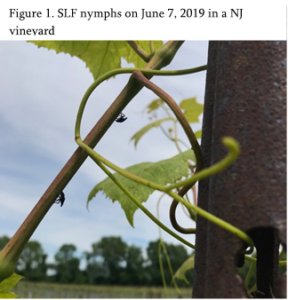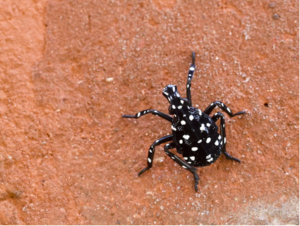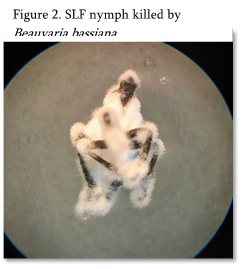Management of Spotted Lanternfly Nymphs in New Jersey Vineyards
Megan Muehlbauer and Anne L. Nielsen
Vineyards in Salem and Hunterdon Counties in New Jersey are beginning to report spotted lanternfly (SLF) nymph sightings (Figure 1). These small black nymphs have white dots on their abdomens and will hop if disturbed. Although it is concerning to find them in large numbers in vineyards, we are not recommending that grape growers spray insecticides at the nymph stage.


(Photo Credit: https://www.pottsmerc.com)
Why? Thus far, there has been no definitive research showing that young SLF nymphs cause damage to grapes. If SLF is feeding on grapes during the 1st and 2nd instar (nymph) stages, they are likely feeding on the fleshly new growth, not on the canes or cordon as the adults do.
However, these nymphs are also likely representing a very low number of the total population of SLF in and around the vineyard they are being seen at, because research has also shown that nymphs feed on multiple host plants. To further elucidate details of SLF life cycle, and feeding habits, we are surveying to determine which life stages are found in commercial vineyards throughout the growing season.
As you make a decision on whether to spray the nymphs in your vineyard, It is important to keep these two points in mind.
1) Do not overuse pyrethroids in a vineyard as they can flare mealybug populations which vector leaf roll virus.
2) Save highly effective insecticides with good residual (Brigade, Actara, Scorpion, Carbaryl, and Mustang Maxx) for use against the adults in late summer through harvest.
If you want a material to apply now while the nymphs are just becoming active in the vineyard, the biological pesticides, BoteGHA (1-2 qt/acre) or BotaniGard 22 WP (0.5- 2 lbs/acre), are effective against the nymphs and will minimally impact other pests. These products have Beauvaria bassiana, a beneficial fungus that attacks insects and has good efficacy against SLF nymphs and a 4 hour REI. Keep in mind when using B. bassiana materials, they take a few days to kill SLF and the fungal growth will turn the nymphs into fuzzy white cotton balls (Fig 2). As a biological material they work best under humid conditions. Recommendations tank mix compatibility for BoteGHA can be found here

There are two other pests in NJ vineyards, grape berry moth and Japanese beetles, that commonly require management in the early summer. While there is no action threshold for SLF nymphs in the vineyard, management can be combined with existing pest management programs. Grape berry moth timing is approaching and we recommend using an insecticide that is effective against both SLF nymphs and grape berry moth if you have SLF nymphs in your vineyard (Table 1).
Just remember that the degree-day timing for grape berry moth is based on using growth regulators or diamide chemistries and application of a broad-spectrum material would be applied 1-2 days after the predicted timing. Japanese beetles typically occur in late June/July and again, there are insecticide materials that are effective against both SLF nymphs and Japanese beetle (Table 1).
Table 1. Insecticide efficacy against SLF nymphs and key grape pests
| Rating of Insecticide Efficacy* | |||
| Insecticide | SLF Nymph ** | Grape Berry Moth | Japanese Beetle |
| Avaunt 30SG | E | G | G |
| Brigade 10WSB | E | E | – |
| Entrust 2SC | F | G | – |
| Imidan 70WP | E | G | – |
| Carbaryl | E | G | G |
| Actara 25 WG | E | – | G |
*E – Excellent; G – Good; F – Fair; ‘-‘ not rated
**H Leach, DJ Biddinger, G Krawczyk, E Smyers, JM Urban 2019 “Evaluation of insecticides for control of the spotted lanternfly, Lycorma delicatula, (Hemiptera: Fulgoridae), a new pest of fruit in the Northeastern U.S.” Crop Protection 124:104833
The recommendations for spotted lanternfly control are centered around the adult stage which are considered the primary damaging stage. If adults are found in your vineyard they likely warrant management. In 2019 we saw SLF move into Northern NJ vineyards in large numbers at the end of September. It is important to note that they do not discriminate between vines that have been harvested or not. The only available threshold for SLF in grapes is 10 adults/vine, however this is quickly exceeded in some vineyards. We are recommending that growers apply a border spray targeting the vines on the borders or the first few panels if rows are perpendicular around your vineyard, with a focus on areas near hedgerows as it has been shown that those are the areas that SLF if most likely to congregate in at higher densities. Further information on adult SLF control, recommended insecticides and rates will be in a forthcoming Plant and Pest Advisory Post.

